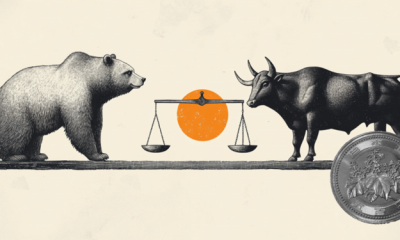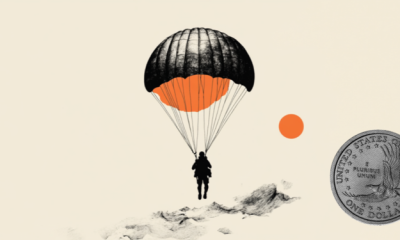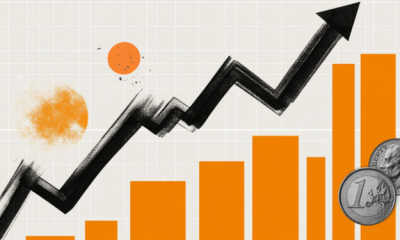

others
US Dollar edges lower as markets await December CPI figures – Crypto News
- DXY Index registers minor losses, trading around 102.40.
- Investors are on standby awaiting CPI figures to be released on Thursday.
- Lower US yields limit the US Dollar advance.
The US Dollar (USD) observed modest losses on Wednesday, trailing at 102.4 in the US Dollar Index, as market participants stick to the sidelines awaiting drivers. The trading floors were relatively quiet with no significant reports fuelling reactions during the session. The focus is set on the release of the US Consumer Price Index (CPI) from December, due on Thursday.
For now, markets are betting on five rate cuts in 2024, largely dismissing the Federal Reserve (Fed) forecast of only 75 bps of easing. Strong labor market data from the US economy was largely offset by a weak US ISM PMI print, so December’s CPI reading will play a big role in shaping expectations of the central bank’s easing calendar.
Daily digest market movers: US Dollar edges lower on quiet Tuesday, Fed Williams will be on the wires
- The US economy demonstrates continued expansion above trend with Q4 and possibly Q1 growth, bolstered by loose financial conditions.
- The US Dollar remains vulnerable as market easing expectations for the Federal Reserve remain high yet unmet. Fed’s Williams will be on the wires by the end of the American session, which may move markets.
- For Thursday, the December Consumer Price Index is projected to come in at 3.2% YoY, above the previous 3.1%. The core annual reading, however, is expected at 3.8%, easing from 4% in November.
- US bond yields, specifically for the 2, 5 and 10-year bonds, are on a downward trajectory. The yields are seen at 4.35%, 3.96% and 4.02%, which should limit upside for the USD.
- Market anticipations gauged through the CME FedWatch Tool suggest a hold on rates in the upcoming January meeting is priced in. Cuts in interest rates are, however, expected around March and May 2024.
Technical Analysis: DXY bulls are undecided as sellers sit just around the corner
The indicators on the daily chart reflect a decrease in buying momentum and increase in selling pressure. The Relative Strength Index (RSI), which is on a negative slope and in negative territory, suggests that bears are around the corner.
In addition, a decreasing histogram of green bars in the Moving Average Convergence Divergence (MACD) indicator confirms the growing bearish sentiment, indicative of a decrease in bullish momentum. Despite bulls taking a breather, they still are struggling to make a decisive upward move.
This lack of bullish momentum is also confirmed by the position of the index in relation to the Simple Moving Averages (SMAs). While it remains above the 20-day SMA, it is under the broader 100 and 200-day SMAs, suggesting bears are maintaining a bullish grip on the larger time horizon.
Support levels: 102.30, 102.00 (20-day SMA), 101.80.
Resistance levels: 102.70, 102.90, 103.00.
Inflation FAQs
Inflation measures the rise in the price of a representative basket of goods and services. Headline inflation is usually expressed as a percentage change on a month-on-month (MoM) and year-on-year (YoY) basis. Core inflation excludes more volatile elements such as food and fuel which can fluctuate because of geopolitical and seasonal factors. Core inflation is the figure economists focus on and is the level targeted by central banks, which are mandated to keep inflation at a manageable level, usually around 2%.
The Consumer Price Index (CPI) measures the change in prices of a basket of goods and services over a period of time. It is usually expressed as a percentage change on a month-on-month (MoM) and year-on-year (YoY) basis. Core CPI is the figure targeted by central banks as it excludes volatile food and fuel inputs. When Core CPI rises above 2% it usually results in higher interest rates and vice versa when it falls below 2%. Since higher interest rates are positive for a currency, higher inflation usually results in a stronger currency. The opposite is true when inflation falls.
Although it may seem counter-intuitive, high inflation in a country pushes up the value of its currency and vice versa for lower inflation. This is because the central bank will normally raise interest rates to combat the higher inflation, which attract more global capital inflows from investors looking for a lucrative place to park their money.
Formerly, Gold was the asset investors turned to in times of high inflation because it preserved its value, and whilst investors will often still buy Gold for its safe-haven properties in times of extreme market turmoil, this is not the case most of the time. This is because when inflation is high, central banks will put up interest rates to combat it.
Higher interest rates are negative for Gold because they increase the opportunity-cost of holding Gold vis-a-vis an interest-bearing asset or placing the money in a cash deposit account. On the flipside, lower inflation tends to be positive for Gold as it brings interest rates down, making the bright metal a more viable investment alternative.
-

 Cryptocurrency6 days ago
Cryptocurrency6 days agoSUI eyes 24% rally as bullish price action gains strength – Crypto News
-

 Cryptocurrency5 days ago
Cryptocurrency5 days agoCoinbase scores major win as SEC set to drop lawsuit – Crypto News
-

 Blockchain1 week ago
Blockchain1 week agoXRP Price Pulls Back From Highs—Are Bulls Still in Control? – Crypto News
-

 others1 week ago
others1 week agoJapanese Yen remains depressed amid modest USD strength; downside seems limited – Crypto News
-

 Business1 week ago
Business1 week agoWhat Will be KAITO Price At Launch? – Crypto News
-

 Cryptocurrency1 week ago
Cryptocurrency1 week agoHayden Davis crypto scandal deepens as LIBRA memecoin faces fraud allegations – Crypto News
-

 Business1 week ago
Business1 week agoWhales Move From Shiba Inu to FXGuys – Here’s Why – Crypto News
-

 Cryptocurrency13 hours ago
Cryptocurrency13 hours agoBinance CEO: we’re seeing a “tactical retreat” with crypto “not a reversal” – Crypto News
-

 Business1 week ago
Business1 week agoElon Musk’s DOGE Launches Probe into US SEC, Ripple Lawsuit To End? – Crypto News
-

 others1 week ago
others1 week agoForex Today: What if the RBA…? – Crypto News
-

 Technology1 week ago
Technology1 week agoLuminious inverters for your home to never see darkness again – Crypto News
-

 Technology6 days ago
Technology6 days agoStellantis Debuts System to Handle ‘Routine Driving Tasks’ – Crypto News
-

 others1 week ago
others1 week agoGas prices still remain elevated – ING – Crypto News
-

 Blockchain1 week ago
Blockchain1 week agoXRP Set To Outshine Gold? Analyst Predicts 1,000% Surge – Crypto News
-

 Technology5 days ago
Technology5 days agoWhy is BTC Down Today? – Crypto News
-

 Technology5 days ago
Technology5 days agoWhy is BTC Down Today? – Crypto News
-

 Technology5 days ago
Technology5 days agoWhy is BTC Down Today? – Crypto News
-

 Blockchain1 week ago
Blockchain1 week agoXRP Price Settles After Gains—Is a Fresh Upside Move Coming? – Crypto News
-

 others1 week ago
others1 week agoWTI price bullish, according to FXStreet data – Crypto News
-

 Metaverse1 week ago
Metaverse1 week agoHow AI will divide the best from the rest – Crypto News
-

 Business1 week ago
Business1 week agoThese 3 Altcoins Will Help You Capitalize on Stellar’s Recent DIp – Crypto News
-

 Business1 week ago
Business1 week agoNew Bitcoin Spiral Clock Model Predicts When Price Will End Bull Cycle – Crypto News
-

 Business1 week ago
Business1 week agoWhy Ethereum (ETH) Price Revival Could Start Soon After Solana Mess? – Crypto News
-

 Cryptocurrency1 week ago
Cryptocurrency1 week agoJudge Assigned to Probe Argentina’s President Milei Over Alleged Crypto Scam – Crypto News
-

 Business1 week ago
Business1 week agoMEXC COO Tracy Jin on How AI Agents are transforming Web3 – Crypto News
-

 Blockchain1 week ago
Blockchain1 week agoSolana Risks Further Drop – Is The SOL ‘Memecoin Fiesta’ Over? – Crypto News
-

 Technology1 week ago
Technology1 week agoHYPE Price Shoots 10% As Hyperliquid EVM Goes Live – Crypto News
-

 Cryptocurrency1 week ago
Cryptocurrency1 week agoRipple Whale Bags 20M Coins Amid Recent Dip, What’s Happening? – Crypto News
-

 Technology1 week ago
Technology1 week agoOnePlus 13 Mini tipped to retain OnePlus 13’s 6,000 mAh battery, launch timeline surfaces – Crypto News
-

 Technology1 week ago
Technology1 week agoUnion Minister Ashwini Vaishnaw to launch India AI Mission portal soon, 10 companies set to provide 14,000 GPUs – Crypto News
-
others1 week ago
Turkey Budget Balance increased to -139.26B in January from previous -829.2B – Crypto News
-

 Business1 week ago
Business1 week agoMarket Veteran Predicts XRP Price If Ripple Completes Cup and Handle Pattern – Crypto News
-

 others1 week ago
others1 week agoUS Dollar struggles to gather traction on quiet Monday – Crypto News
-

 Business1 week ago
Business1 week agoWill Pi Network Price Outperform Bitcoin After Mainnet Launch? – Crypto News
-

 others1 week ago
others1 week agoGold price in Pakistan: Rates on February 18 – Crypto News
-

 Cryptocurrency1 week ago
Cryptocurrency1 week agoBitcoin Sees $430M in Outflows as Market Responds to Fed’s Hawkish Stance – Crypto News
-

 others1 week ago
others1 week agoRallying on unchanged rate projections – ING – Crypto News
-

 Blockchain7 days ago
Blockchain7 days agoThe Secret Window You Need To Know – Crypto News
-

 Technology6 days ago
Technology6 days agoReliance Jio unveils ₹949 prepaid plan with 3-month JioHotstar subscription: Validity, data, SMS and other details – Crypto News
-

 Technology6 days ago
Technology6 days agoApple Watch Series 10 gets a discount of over ₹5,000 on Amazon: How to get it for ₹41,705 – Crypto News
-

 Cryptocurrency6 days ago
Cryptocurrency6 days agoCanary’s Litecoin ETF listed on DTCC – Will trading begin soon? – Crypto News
-

 Technology4 days ago
Technology4 days agoXRP Price Prediction Today 22 February – Crypto News
-

 Cryptocurrency3 days ago
Cryptocurrency3 days agoRaydium Token Dips 22% as Rumors Swirl on Pump.Fun Changes – Crypto News
-

 others2 days ago
others2 days agoElliptic Says Lazarus Group Using eXch To Launder Stolen Funds Despite Requests From Bybit To Block Transactions – Crypto News
-

 Technology1 week ago
Technology1 week agoSouth Korea removes DeepSeek from app stores, existing users advised to ‘service with caution’ – Crypto News
-

 Blockchain1 week ago
Blockchain1 week agoBitcoin Price Falls Short Again—Is a Deeper Decline Coming? – Crypto News
-

 Technology1 week ago
Technology1 week agoBest portable bass Bluetooth speakers for ultimate music experience – Crypto News
-

 Business1 week ago
Business1 week ago3 Crypto Stocks That Could 10X as Paul Tudor Jones Ups Bitcoin ETF Holdings – Crypto News
-

 Business1 week ago
Business1 week agoCardano Price Could Hit $7 Amid Growing Adoption – Crypto News
-

 Cryptocurrency1 week ago
Cryptocurrency1 week agoBitcoin company joins the publicly traded ‘Fold’ – Crypto News
















